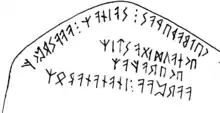ᛖᚲ
Proto-Norse

the inscription on the Hogganvik runestone
Alternative forms
- ᛖᚴ (ek), ᛖᚴᛡ (ekᴀ), -ᛖᚳᚨ (-eka), -ᚴᛡ (-kᴀ)
Etymology
From Proto-Germanic *ek, from Proto-Indo-European *éǵh₂. Among the earliest attestations of the pronoun is the inscription on the 2nd-4th century Lindholm amulet, which also contains a postpositive, perhaps clitic, form of the word, ᚺᚨᛏᛖᚳᚨ (hateka, “I am called”).
Pronoun
ᛖᚲ (ek)
- I
- c. 250–450, inscription on the Tune stone:
- ᛖᚲᚹᛁᚹᚨᛉᚨᚠᛏᛖᚱᚹᛟᛞᚢᚱᛁᛞᛖ / […]
- ekwiwaʀafterwoduride / […]
- I, Wiwaz, after Woduridaz / […]
- c. 425, inscription on the Golden Horns of Gallehus:
- ᛖᚲᚺᛚᛖᚹᚨᚷᚨᛊᛏᛁᛉ᛬ᚺᛟᛚᛏᛁᛃᚨᛉ᛬ᚺᛟᚱᚾᚨ᛬ᛏᚨᚹᛁᛞᛟ᛬
- ekhlewagastiʀ᛬holtijaʀ᛬horna᛬tawido᛬
- I, Hlewagastiz Holtijaz, made the horn
- c. 250-450, inscription on the Hogganvik runestone:
- ᛖᚲᚾᚨᚢᛞᛁᚷᚨᛋᛏᛁᛉ / […]
- eknaudigastiʀ / […]
- I, Naudigastiz, / […] [1]
- c. 250–450, inscription on the Tune stone:
Related terms
- ᛗᛖᛉ (meʀ) (dative)
Descendants
- Old Norse: ek, iak; ec; -k
- Icelandic: ek, eg, ég
- Faroese: eg, jeg
- Norn: eg
- Norwegian: ej, é, eig, í, æg, æj, æ, je, jæj (dialectal)
- Norwegian Nynorsk: eg
- Jamtish: jeg
- Dalian: ik, ig
- Elfdalian: ig
- Westrobothnian: jäg, jeg, jig, jög
- Old Swedish: iak, iæk, iagh
- Swedish: jag
- Old Danish: iak, iæk, iægh, æk, ak
- Danish: jeg, a, æ, ja, jæ
- Norwegian Bokmål: jeg
- Scanian: jağ
- Danish: jeg, a, æ, ja, jæ
- Jutish: æ
- Old Gutnish: iek
References
- James E. Knirk, Runic inscription from Hogganvik, Mandal, Vest-Agder (2009) (preliminary report), 27 October 2009